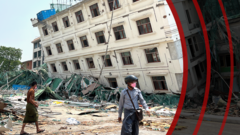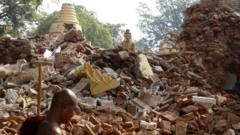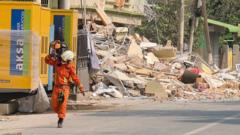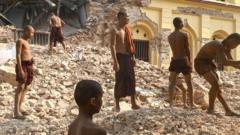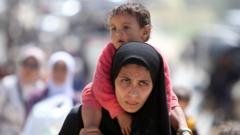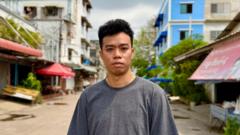Mandalay, known for its iconic golden structures, is now engulfed in tragedy as a recent earthquake has claimed thousands of lives, leaving survivors in a dire struggle for aid.
**Mandalay's Desperate State: A Historic City Struck by Tragedy**
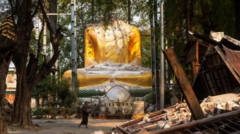
**Mandalay's Desperate State: A Historic City Struck by Tragedy**
The devastation in Mandalay follows a powerful earthquake, leaving a city that once sparkled in gold mourning amidst chaos.
Despite its former glory, Mandalay, with its shimmering pagodas, now finds itself suffocating under the weight of mourning and death following a catastrophic earthquake. The 7.7 magnitude tremor that struck close to the city last Friday has resulted in a staggering death toll of over 2,700, with expectations of the numbers climbing amidst ongoing aftershocks. A resident lamented the grim reality of bodies being cremated in stacks as the military government faces criticism for inadequate disaster response.
Despair hangs heavy in the air as families, drastically affected, roam the streets, grappling with dwindling food and water supplies. Many residents, including a distraught woman named J, shared their traumatic experiences of sleep deprivation and fear as aftershocks continue to threaten their already damaged homes. Life as they knew it has been replaced by living in makeshift tents, struggling to stay afloat amidst the rubble.
Amidst the destruction, some hope remains, as rescue operations led by local fire services have managed to recover hundreds of people over the past few days. Yet, the true extent of casualties is believed to be much higher than reported figures. In a stark contrast to the military's official statements, independent reports from geologists suggest the actual death toll could surpass 10,000 due to the quake's size and impact on densely populated areas.
The trauma inflicted, especially on vulnerable children, remains a harrowing aspect of this disaster. For instance, one local pastor remarked on the deep emotional toll it has taken on his young son after witnessing neighbor's homes collapse. The somber reality is exacerbated by overwhelming grief and hopelessness felt by residents as they search for answers and assistance.
With countless bodies still unaccounted for, crematoriums nearby have reached their limits, struggling to cope with the sheer number of deceased. Amidst the remnants of golden pagodas, stark reminders of past beauty, the city struggles under the rising tide of despair. Food and water shortages deepen, leaving residents questioning the effectiveness of ongoing rescue efforts amid a backdrop of extensive civil unrest and governance failures.
Myanmar’s military, grappling with the aftermath of both the quake and ongoing internal conflicts since a coup in 2021, attempts to maintain order while relief efforts face obstruction. The international community has responded, but the junta's history of repression complicates the flow of aid. Calls from organizations like Human Rights Watch demand immediate access for humanitarian workers to assist those in dire need.
As the nation holds a week of mourning and seeks to pay tribute to the lives lost, the devastating impact of the earthquake serves as a stark reminder of the challenges facing Myanmar amidst natural calamities and human-made crises. The path to recovery appears long and fraught with obstacles as the people of Mandalay strive to rebuild their lives in a shattered landscape.
Despair hangs heavy in the air as families, drastically affected, roam the streets, grappling with dwindling food and water supplies. Many residents, including a distraught woman named J, shared their traumatic experiences of sleep deprivation and fear as aftershocks continue to threaten their already damaged homes. Life as they knew it has been replaced by living in makeshift tents, struggling to stay afloat amidst the rubble.
Amidst the destruction, some hope remains, as rescue operations led by local fire services have managed to recover hundreds of people over the past few days. Yet, the true extent of casualties is believed to be much higher than reported figures. In a stark contrast to the military's official statements, independent reports from geologists suggest the actual death toll could surpass 10,000 due to the quake's size and impact on densely populated areas.
The trauma inflicted, especially on vulnerable children, remains a harrowing aspect of this disaster. For instance, one local pastor remarked on the deep emotional toll it has taken on his young son after witnessing neighbor's homes collapse. The somber reality is exacerbated by overwhelming grief and hopelessness felt by residents as they search for answers and assistance.
With countless bodies still unaccounted for, crematoriums nearby have reached their limits, struggling to cope with the sheer number of deceased. Amidst the remnants of golden pagodas, stark reminders of past beauty, the city struggles under the rising tide of despair. Food and water shortages deepen, leaving residents questioning the effectiveness of ongoing rescue efforts amid a backdrop of extensive civil unrest and governance failures.
Myanmar’s military, grappling with the aftermath of both the quake and ongoing internal conflicts since a coup in 2021, attempts to maintain order while relief efforts face obstruction. The international community has responded, but the junta's history of repression complicates the flow of aid. Calls from organizations like Human Rights Watch demand immediate access for humanitarian workers to assist those in dire need.
As the nation holds a week of mourning and seeks to pay tribute to the lives lost, the devastating impact of the earthquake serves as a stark reminder of the challenges facing Myanmar amidst natural calamities and human-made crises. The path to recovery appears long and fraught with obstacles as the people of Mandalay strive to rebuild their lives in a shattered landscape.

